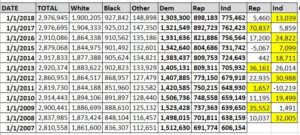JMC Analytics and Polling periodically analyzes voter registration data updated on a monthly basis by the Secretary of State as a means of staying abreast of demographic/population trends in Louisiana. According to the most recent (January 1, 2018) statistical report, statewide voter registration (both active and inactive voters) was 2.98 million, a number that has remained virtually unchanged since January 2017.
The current racial breakdown of those registrants is 64-31% white/black, while partisan registration is 44% Democrat, 30% Republican, and 26% Independent – figures that have changed very little since January 2017.
However, a more detailed examination of the data reveals the continuation of several long-term trends:
The vanishing white Democrat: when George W Bush was inaugurated in 2001, white Democrats comprised 35% (or 951K voters) of the Louisiana electorate. That number has steadily declined to 19% (or 552K) at the advent of the Trump administration; it is currently 18% (or 536K).
Steady Republican gains: 22% (or 605K) of the electorate registered Republican when George W Bush was inaugurated in 2001. That has steadily increased to 893K (30%) at the beginning of the Trump administration and is now 898K (also 30%).
A somewhat more diverse electorate: Black voter registration comprised 29% of the electorate at the beginning of the Bush administration and is 31% today. Those classified as “Other” have seen their numbers steadily increase over time to 5% today (64% of registrants are white).
Are Independents on the rise? Over time, those declining to affiliate with either of the two major parties have numerically increased from 18% (or 488K) in 2001 to 26% (or 762K) at the beginning of the Trump administration and 775K (also 26%) today.
Given their steadily increasing numbers, could they eventually outnumber Republicans? While this could happen, the data shows this will not happen any time soon. An examination of yearly changes in partisan voter affiliation over the last 11 years shows that for seven of those years, Independents showed greater numerical gains than Republicans. However, those gains were all in “off years”, and were more than offset by larger Republican gains in Presidential years. To illustrate, during 2016 (a Presidential year), the count of Republicans increased by 70,837, while the increase among Independents was only 5,859. That was more than enough to offset the “off year” gains by Independents between 2013-2015, when they “out registered” Republicans 50,632 to 12,575.
Independents/unaffiliateds face an additional challenge: they don’t turn out as much as Democrats/Republicans. In the last two Presidential elections, overall voter turnout was 68% each time, while Independent turnout averaged 55%. Similarly, in Senate/Gubernatorial races in 2014/2015/(December) 2016, average overall turnout was 41%, while it was 26% for Independents. And in the Treasurer’s race last year, overall turnout averaged 14% and 7% for Independents. In practical terms, this means that their “influence” in elections is overstated relative to their presence on the voter rolls: while they are 26% of registered voters, their actual electoral influence is only about 20% in Presidential elections and 14-18% in midterm/”off year” elections.
In conclusion, the Louisiana electorate continues to get more racially diverse, with growth coming from all groups but white Democrats, although the much discussed “partisan dealignment” commonly discussed hasn’t yet shown in election results or voter registration statistics.

